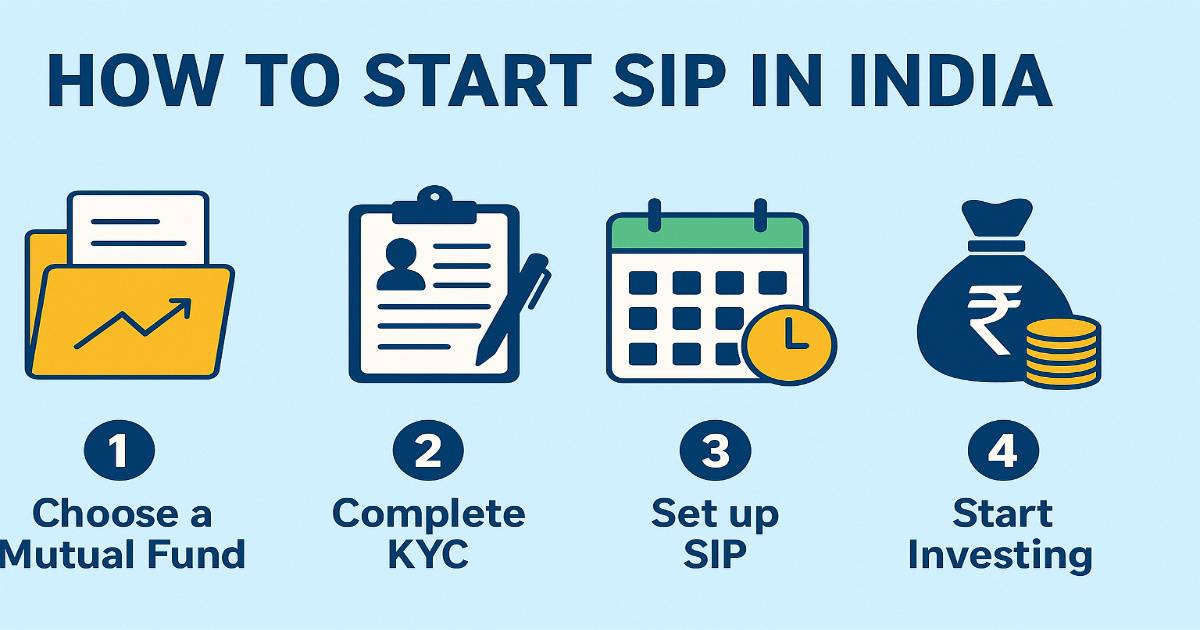Introduction
If you have ever thought, “I want to start investing but don’t know where to begin,” you’re not alone. For beginners in India, the Systematic Investment Plan (SIP) is one of the easiest and smartest ways to start investing in mutual funds.
SIPs allow you to invest small, fixed amounts regularly — monthly, quarterly, or yearly — instead of a large lump sum. This not only builds discipline but also reduces the stress of timing the market.
In this guide, we’ll walk you through how to start SIP in India step-by-step, explain the benefits, share expert tips, and highlight common mistakes to avoid.
What is SIP?
SIP, short for Systematic Investment Plan, is an investment method where you contribute a fixed amount regularly to a mutual fund scheme.
Instead of investing a lump sum, SIP spreads your investment over time, allowing you to:
- Build wealth gradually.
- Reduce the impact of market volatility through Rupee Cost Averaging.
- Enjoy the benefits of compounding.
How does SIP work?
Before investing via SIP in mutual funds, it is essential to understand how it works.
When you set up your SIP, a fixed amount is automatically debited from your registered bank account. The frequency of SIP can be daily, weekly, monthly, quarterly, semi-annually, or annually.
As soon as the amount is debited from your account, the fund house processes your transaction, and you receive mutual funds units as per the current NAV of the fund. Every time you make a SIP, you receive units as per the latest; hence, the number of units you receive varies in each transaction. The SIP works on the power of compounding. Let’s understand this with an example.
Say you start a SIP of Rs 5,000, and the current NAV of the fund is Rs 100. So, after the SIP is debited from your account, you will receive 50 units (Rs 5,000 / Rs 100) of the mutual fund scheme. And let’s say at the time of your second SIP, the NAV of the fund increases to Rs 110; then, in this case, you will have 45.45 units. The SIP can provide a decent amount of money as a return on your investment through the power of compounding.
How to Invest in SIP in India?
Investing in SIP in India is a simple and structured process. Here’s how you can start:
1. Understand SIP Basics
SIP allows you to invest a fixed sum regularly in a mutual fund, helping you build wealth over time without worrying about market timing.
2. Define Your Goal
Your investment goal decides your fund type:
- Short-term goals → Debt or hybrid funds.
- Medium-term goals → Balanced funds.
- Long-term goals → Equity funds.
3. Assess Your Risk Appetite
- Low risk → Debt funds.
- Medium risk → Hybrid funds.
- High risk → Equity funds.
4. Complete KYC
As per SEBI rules, KYC is mandatory.
- Required documents: PAN, Aadhaar (linked to mobile), bank proof, passport-size photo.
- Complete KYC online via AMC websites or platforms like Groww, ET Money, Zerodha Coin.
5. Select the Mutual Fund Scheme
Research based on:
- Fund type (Equity, Debt, Hybrid).
- Past 5–10 year performance.
- Expense ratio.
- Fund manager’s experience.
6. Choose an Investment Platform
Options include:
- AMC websites (SBI MF, HDFC MF).
- Apps (Groww, Paytm Money, Kuvera).
- Brokers (Zerodha Coin, Upstox).
- Banks.
7. Decide SIP Amount & Date
Start with an amount you can sustain (min ₹500). Pick a debit date after your salary credit.
8. Set Up Auto-Payment
Sign an ECS/NACH mandate to ensure timely automatic deductions.
9. Monitor & Review
Review performance every 6–12 months and avoid stopping during market downturns.
Why SIP is the Best Way to Start Investing in India
1. Affordable for Everyone
You can start with as little as ₹500 per month, making it accessible to students, salaried individuals, and small business owners alike.
2. Rupee Cost Averaging
When markets are low, your fixed investment buys more units. When markets are high, you buy fewer units. Over time, this averages out your cost.
3. Power of Compounding
Your returns generate further returns over time. Even small investments can grow into large amounts if you stay invested long enough.
4. Promotes Discipline
Since SIPs auto-debit from your bank, you build the habit of saving before spending.
Types of SIP in India
Before starting, understand the different SIP options available:
- Regular SIP – Fixed amount at fixed intervals.
- Top-up SIP – Increase your SIP amount at regular intervals.
- Flexible SIP – Change your SIP amount as per your financial condition.
- Perpetual SIP – No end date; continues until you stop it.
- Trigger SIP – Starts when specific conditions (like market levels) are met.
Step-by-Step Guide to Start SIP in India
(You can also treat this as a checklist for the above process.)
- Set financial goals.
- Assess risk profile.
- Complete KYC.
- Choose the right mutual fund.
- Decide SIP amount & duration.
- Select an investment platform.
- Set up auto-debit.
- Monitor your SIP.
Advantages of SIP Over Lump Sum
| Feature | SIP | Lump Sum |
|---|---|---|
| Entry barrier | Low (₹500) | High |
| Market timing needed | No | Yes |
| Risk level | Lower | Higher |
| Habit building | Yes | No |
SIP Calculator
How to Start SIP Online in India
Starting a SIP online is quick, paperless, and can be done in just a few minutes. Here’s a step-by-step process you can follow:
1. Choose an Online Investment Platform
You can start SIP online through:
- AMC (Mutual Fund Company) Websites – e.g., SBI Mutual Fund, HDFC Mutual Fund.
- Investment Apps & Portals – Groww, ET Money, Paytm Money, Kuvera.
- Broker Platforms – Zerodha Coin, Upstox, Angel One.
2. Complete Your e-KYC
KYC is mandatory before investing. Online KYC (e-KYC) is fast and requires:
- PAN Card
- Aadhaar Card (linked with mobile number for OTP)
- Bank account details
- Passport-size photo
You can complete e-KYC directly on the AMC website or the investment platform.
3. Select the Mutual Fund Scheme
While selecting a scheme, check:
- Fund type (Equity, Debt, Hybrid)
- Past 5–10 year performance
- Expense ratio
- Fund manager’s track record
Things to Consider Before Starting Your SIP
Starting a SIP is easy, but making the most out of it requires planning and awareness. Here are some important factors to think about before you begin:
1. Define Your Financial Goals
Before investing, be clear on why you are investing:
- Short-term goals (1–3 years) → Safer options like debt funds.
- Medium-term goals (3–5 years) → Balanced/hybrid funds.
- Long-term goals (5+ years) → Equity funds.
2. Understand Your Risk Appetite
Your comfort with market ups and downs should guide your fund choice:
- Low Risk: Debt or liquid funds.
- Medium Risk: Hybrid or balanced funds.
- High Risk: Equity funds (large-cap, mid-cap, small-cap).
3. Choose the Right Mutual Fund
Do research before selecting:
- Look at past performance (over 5–10 years).
- Check expense ratio (lower is better).
- Review fund manager’s track record.
- Ensure it matches your investment goal.
4. Decide SIP Amount Wisely
Pick an amount that you can consistently invest every month without straining your budget. Even small amounts like ₹500–₹1,000 can grow significantly over time.
5. Duration of Investment
SIPs work best when you stay invested for the long term. Ideally, keep a minimum horizon of 5–10 years for equity SIPs to ride out market volatility.
6. Direct Plan vs. Regular Plan
- Direct Plan: Invest directly with AMC; lower expense ratio, higher returns.
- Regular Plan: Invest through agents/distributors; expense ratio is slightly higher.
7. Tax Implications
- Equity funds: Gains held over 1 year → 10% LTCG tax if gains exceed ₹1 lakh/year.
- Debt funds: Taxed as per income slab after indexation benefits (if held >3 years).
8. Platform Charges
If you’re investing via an app or broker, check if they charge transaction fees or platform charges.
Conclusion
Systematic Investment Plans (SIPs) are one of the most convenient and disciplined ways to build wealth over time. They help you invest small amounts regularly, reduce the impact of market volatility through rupee cost averaging, and harness the power of compounding. Whether you are a beginner or an experienced investor, SIPs can be aligned with your financial goals—be it buying a house, funding your child’s education, or planning for retirement.
The key is to start early, stay consistent, and remain patient. Don’t panic during market fluctuations; instead, trust the process and focus on your long-term objectives. With the right planning, fund selection, and discipline, SIPs can become a powerful tool to achieve financial freedom in India.
Frequently Asked Questions (FAQs) about SIP in India
What is the minimum amount required to start a SIP?
You can start a SIP in India with as little as ₹500 per month. Some mutual funds and platforms even allow starting from ₹100.
Can I change my SIP amount later?
Yes. You can increase or decrease your SIP amount by submitting a modification request to the AMC or updating it through your investment platform.
Which is better — SIP or lump sum?
If you have a large amount ready, lump sum may work in certain cases, but SIP is ideal for salaried individuals and beginners because it spreads investment over time and reduces risk.
Can I pause or stop my SIP anytime?
Yes. You can pause or stop your SIP anytime without penalties by submitting an online/offline request to the AMC or platform.







